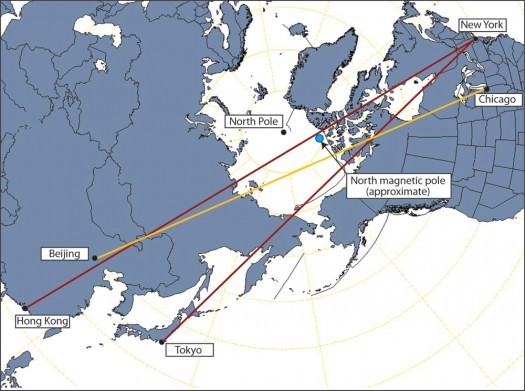Space Weather for Air Travelers
January 2007By By Dr. Tony Phillips
By Dr. Tony Phillips;>> Macro menumgr_macro_spaceplaceimage not found <<
The reason for the increase is commerce. Business is booming along Asia’s Pacific Rim, and business travel is booming with it. On our spherical Earth, the shortest distance from Chicago to Beijing or New York to Tokyo is over the North Pole. Suddenly, business travelers are spending a lot of time in the Arctic. With these new routes, however, comes a new concern: space weather.
“Solar storms have a big effect on polar regions of our planet,” explains Steve Hill of NOAA’s Space Weather Prediction Center in Boulder, Colorado. Everyone knows about the Northern Lights, but there’s more to it than that: “When airplanes fly over the poles during solar storms, they can experience radio blackouts, navigation errors and computer reboots—all caused by space radiation.”
In 2005, United Airlines reported dozens of flights diverted from polar routes by nasty space weather. Delays ranged from 8 minutes to nearly 4 hours, and each unplanned detour burned expensive fuel. Money isn’t the only concern: Pilots and flight attendants who fly too often over the poles could absorb more radiation than is healthy. “This is an area of active research—figuring out how much exposure is safe for flight crews,” says Hill. “Clearly, less is better.”
To help airlines avoid bad space weather, NOAA has begun equipping its GOES weather satellites with improved instruments to monitor the Sun. Recent additions to the fleet, GOES 12 and 13, carry X-ray telescopes that take spectacular pictures of sunspots, solar flares, and coronal holes spewing streams of solar wind in our direction. Other GOES sensors detect solar protons swarming around our planet, raising alarms when radiation levels become dangerous.
“Our next-generation satellite will be even better,” says Hill. Slated for launch in 2014, GOES-R will be able to photograph the Sun through several different X-ray and ultra-violet filters. Each filter reveals a somewhat different layer of the Sun’s explosive atmosphere—a boon to forecasters. Also, advanced sensors will alert ground controllers to a variety of dangerous particles near Earth, including solar protons, heavy ions and galactic cosmic rays.
“GOES-R should substantially improve our space weather forecasts,” says Hill. That means friendlier skies on your future trips to Tokyo.
For the latest space weather report, visit the website of the Space Weather Prediction Center at http://www.sec.noaa.gov/. For more about the GOES-R series spacecraft, see http://goespoes.gsfc.nasa.gov/goes/spacecraft/r_spacecraft.html. For help in explaining geostationary orbits to kids—or anyone else—visit The Space Place at http://spaceplace.nasa.gov/en/kids/goes/goes_poes_orbits.shtml .

The shortest airline routes from the Eastern U.S. to popular destinations in Asia go very near the magnetic North Pole, where space weather is of greatest concern.
This article was provided by the Jet Propulsion Laboratory, California Institute of Technology, under a contract with the National Aeronautics and Space Administration.



